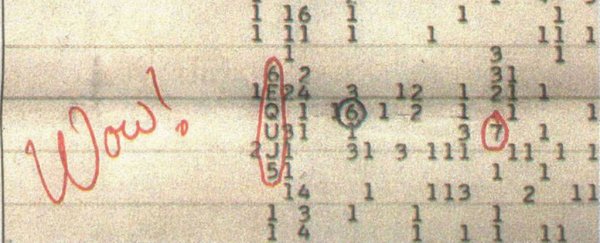In 1977, the sound of extraterrestrials was heard by human ears for the first time - or so people at the time thought. The Wow! Signal was detected by astronomer Jerry Ehman using Ohio State University's Big Ear radio telescope.
It is a radio signal detector that, at the time, was pointed at a group of stars called Chi Sagittarii in the constellation Sagittarius.
When scanning the skies around the stars, Ehman captured a 72 second burst of radio waves: he circled the reading and wrote "Wow!: next to it, hence the signal's name.
Over the last 40 years, the signal has been cited as evidence that we are not alone in the galaxy. Experts and laypeople alike believed that, finally, we had evidence of alien life. Big Ear Radio Observatory and NAAPO
Big Ear Radio Observatory and NAAPO
However, Antonio Paris, of St Petersburg College, has now discovered the explanation: a pair of comets. The work was published in the Journal of the Washington Academy of Sciences.
These comets, known as 266P/Christensen and 335P/Gibbs, have clouds of hydrogen gas millions of kilometres in diameter surrounding them.
The Wow! Signal was detected at 1420MHz, which is the radio frequency hydrogen naturally emits.
Notably, the team has verified that the comets were within the vicinity at the time, and they report that the radio signals from 266/P Christensen matched those from the Wow! signal.
While this discovery is a disappointment to alien enthusiasts everywhere, as the Wow! Signal is the strongest signal we have ever received from space, it is a testament to our ability to accurately interpret signals and sounds from the cosmos.
This gives us hope in our attempt to decode the hundreds of "strange, alien" signals coming from other stars that have been observed recently.
We have several weapons in our cosmic detection arsenal, most of which are used by the Search for Extra-Terrestrial Intelligence Institute (SETI).
Their main means of detection is using radio-telescopes, and their most ambitious project to date has been 'Project Phoenix'; the "world's most sensitive and comprehensive search for extraterrestrial intelligence".
For this project, they used three of world's biggest radio telescopes: the Parkes radio telescope in Australia (210 feet or 64 metres in diameter), the National Radio Astronomy Observatory in West Virginia (140 feet or 40 metres in diameter), and Arecibo Observatory in Puerto Rico (the world's largest at 1,000 feet or 300 metres in diameter).
They have also built The Allen Telescope Array with financial backing from Paul Allen.
While the technology for detecting alien messages is remaining relatively static, ideas for communicating better with our own satellites is advancing rapidly, with possibilities including communicating by a laser beam and establishing a space satellite network.
This article was originally published by Futurism. Read the original article.
